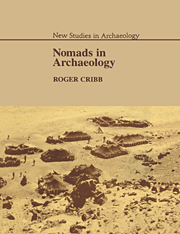Book contents
- Frontmatter
- Contents
- List of illustrations
- List of tables
- Preface
- 1 Introduction
- 2 Origins and definitions
- 3 Nomad pastoral economy
- 4 Residence, descent and territory
- 5 Nomads – the invisible culture?
- 6 Nomad architecture and domestic space
- 7 Ali's camp: a nomad household campsite
- 8 The structure and location of nomad settlements
- 9 Sariaydin Yayla
- 10 The lost world of Nemrut Daḡ
- 11 Nomad archaeology: an assessment
- 12 Towards a model of unstable settlement systems
- References
- Glossary
- Index
12 - Towards a model of unstable settlement systems
Published online by Cambridge University Press: 23 September 2009
- Frontmatter
- Contents
- List of illustrations
- List of tables
- Preface
- 1 Introduction
- 2 Origins and definitions
- 3 Nomad pastoral economy
- 4 Residence, descent and territory
- 5 Nomads – the invisible culture?
- 6 Nomad architecture and domestic space
- 7 Ali's camp: a nomad household campsite
- 8 The structure and location of nomad settlements
- 9 Sariaydin Yayla
- 10 The lost world of Nemrut Daḡ
- 11 Nomad archaeology: an assessment
- 12 Towards a model of unstable settlement systems
- References
- Glossary
- Index
Summary
The future of nomad archaeology in the Near East remains uncertain. With large regions closed to archaeological research through war and political instability or heavily restricted, opportunities for the kind of surveys and excavations necessary to uncover nomad sites on a large scale may not be forthcoming. But neither is this desirable. After all nomad sites should form but one component of a wider regional perspective along with many other kinds of sites. The principles outlined above should provide guidelines in designing representative surveys, recognizing the distinctive features and organization of pastoral settlements and detecting the presence of nomadic or composite dwelling forms.
Theoretical perspectives
This study, I hope, has gone some way towards providing, at least for a certain class of sites, what Binford has referred to as:
a descriptive and analytical procedure which attempts to define the site framework in terms of features and which is followed by a study of the relationships between this skeletal framework and the dispersion of items.
(1983, p. 147)Following recent advances in intra-site spatial analysis to decipher the meaning of item distributions (Whallon 1984; Hodder 1976; Orton 1982), efforts are now being made to tackle the problem of relating such patterns to features. In Chapter 7 of In Pursuit of the Past Binford explores this interaction between site ‘frameworks’ and item patterning, but his observations remain tied to particular activity spaces such as hearths, specialist work areas, etc.
- Type
- Chapter
- Information
- Nomads in Archaeology , pp. 225 - 229Publisher: Cambridge University PressPrint publication year: 1991



